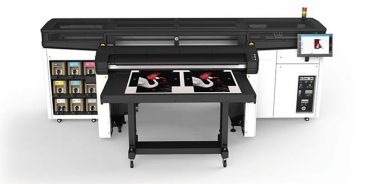Almost 50 days after confining Britons to their homes Prime Minister Boris Johnson has begun to prepare the country for some changes to the lockdown. What better time to hear from some of the leading organisations in our industry about what the future might hold?
EFI
For Frank Mallozzi, chief revenue officer at EFI, some of the biggest changes include the reduction in travel, new rules and regulations and the way he plans for the future. ‘Normally by this time in the year I’d have clocked up over 100,000 miles in the air, this year I’ve barely made 5000!’ Mr Mallozzi explains. ‘Our textile manufacturing facility is located in Bergamo, which was one of the first hotspots outside of China so very early on we understood the impact of this terrible disease. We learned an a lot early on and we took it very seriously.
‘EFI has put a plan in place and we’re certainly not immune to the challenges we’re all facing. But we just don’t know, our crystal ball is cloudy! For me to look at the rest of the year just wouldn’t be right, I’d misguide all the folks out there and I’d be setting the wrong expectations for my customers. So I have to do it in increments, monitoring things week by week. My quarter has become a month, my year has become a quarter and all I can do is think about Q2, then reset and go again for Q3.

The amount of time we all spend in the air has dropped drastically
‘That’s my short term outlook, as we’re in the midst of this situation, but I also need to think about what the business will look like once we get out, because it isn’t going to be the same. The markets that recover are going to be different and I cannot take a peanut butter approach to this thing globally because there will be hotspots and places that are slower to recover. What we’re going to do is focus on the key markets that are going to recover, look at certain segments that are going to recover and put programmes in place.’
What sort of specifics does Mr Mallozzi have in mind? ‘We’re now able to do things that we weren’t when all our resources were embedded in the field. On the software side we’ve actually had some real successes as customers have embraced online demos in a way they never had before.
‘When it comes to industrial print, that is very broad and we’re looking at it a bit differently. This is a chance to take a deeper dive and really understand our customers, for example in retail we expect to see a faster recovery, there are products sat in the supply chain and when shops reopen they’ll all be looking to print vast amounts of promotional material about offers and availability.
‘We’re doing outreach and touching base with all our customers and where possible trying to provide something different. For printers that provide applications for trade shows (which will be a lot slower to recover) we might suggest that the décor market will ramp up quickly. Shops, restaurants and the like will need to reconfigure when they reopen as they are going to need divisions in place for social distancing. We’ve actually created a new segment called divisional graphics which focuses around this.
‘Another area is the queues outside shops, these will be the new norm and what a great opportunity this is for messaging. Likewise floor graphics, how long before people see the opportunity to use those for campaigns? That’s probably the big change, we’re being more creative.’
HP
George Brasher is HP’s managing director for the UK and Ireland. According to Mr Brasher, his company’s priorities are ‘the safety of our employees, the support of our customers and partners, and finding ways to help the wider community.’ He is keen to emphasise that, ‘In many ways, these areas don’t differ from how we operated before Coronavirus – we’ve always placed emphasis on employee happiness and development, always strived to offer the best vendor relationship in the market, and always sought to better the wider world, such as through our Sustainable Impact programmes. What has changed is how we go about achieving these aims.
‘This situation will be with us for a considerable time. Things won’t go away overnight when lockdowns begin to lift. We pledge as a company to help to overcome the challenge together; this is a moment where we all need to look out for one another and to continue to put people first.
‘We are using the full scale of HP’s business to help partners, customers and communities navigate the road ahead – from leveraging global supply chains to fulfil critical orders, to coordinating our 3D printer install base to make protective equipment for the NHS, to making educational content freely available on our ‘HP for Education’ website, to providing flexible finance options for resellers. We urge our customers and partners not to hesitate in reaching out for help.’
All very admirable, but how has this crisis actually changed the way HP works on a day-to-day basis and what will that mean for the future? ‘While working practices have clearly altered beyond anything we could have predicted, many of the changes are in some ways a continuation of trends we were already aware of,’ Mr Brasher stresses. ‘Working from home, for instance, has been a growing mode of work. Now, for many, it has become the only mode. Digital commerce has been on the rise for decades but is now of critical importance. While, in time, elements of office life and face-to-face business will return, organisations will need to continue honing their strategy and infrastructure to support a remote and online-only way of operating and reaching customers.

HP has continued to unveil new products despite the crisis
‘We might also see the rise in community awareness and desire to provide altruistic support, outside of core business operations, remain. In this regard, PSPs can continue their fantastic work of the past few months. Carly Press in the UK is a great example. They’ve been printing free stickers for local residents to put up outside their homes, in order to indicate they are in self-isolation. Utilising their HP Latex 360 printer and some spare press capacity, Carly Press has been able to print clear, bright stickers, and are experiencing growing demand both locally and nationwide.’
Canon
Serving customers to the highest possible standard is a key priority for Duncan Smith, who is Canon’s country director for production printing products. He says. ‘At Canon, we want to continue to serve customers to the highest possible standard, whilst also adapting to current government guidelines. As an organisation, this is about making sure you are being as flexible as possible and listening to customers to find a solution that works for everyone.
‘We recently managed to fulfil a printer order that was required for essential business whilst strictly observing government guidelines around social distancing. Completing this order highlighted just how much our working practices have had to change. For example, to deliver our usual levels of customer service and to ensure the product was running correctly, we had to ship the unit, then supply training remotely.
‘Going forward, this virtual approach will unlikely be mandatory, but the capability to deliver this level of support remotely will become an important part of our overall offering to customers. In the future, customers can expect the usual high levels of support from Canon whatever the circumstances.’
Mr Smith also highlighted the way things have moved in terms of applications, saying ‘Another significant change we are seeing is what our customers are producing with print. For example, the new reality has required the sector to produce significant levels of signage to ensure people can observe social distancing safely, and to inform people of the new health and safety standards.’
Hybrid
For his part Brett Newman, chief operations manager at Hybrid Services, exclusive Mimaki distributor for the UK and Ireland, the challenges posed by social distancing were key. ‘Social distancing has impacted both daily life and working practice from the very start,’ he told DigitalPrinter. ‘For example the challenges for Hybrid’s service engineers of installing and repairing machines as well as training customers has dramatically altered previous ways of working. As a company, and with the health and safety of our staff and customers firmly to the fore, we have implemented radically different approaches to tasks we all took for granted to enable us to function, and we anticipate safe working practices based around social distancing remaining for some time to come.
‘The industry we work in is very much a hands-on, practical, production-led industry so there’s only so much remote working possible, but we suspect that things like video conferencing may in part replace physically attended demonstrations, and more virtual events will come to the fore in the coming months.

Amidst all the uncertainty , remote working seems here to stay
‘The current crisis has also changed the way that many products are being produced and we are naturally seeing an increase in customer activity with more guidance notices, floor graphics and the like generated for social distancing and queue management. The production of physical barriers at checkouts and potential contact points all offer branding and messaging opportunities, and benefit from what digital print can bring to the design and manufacturing process.’
New products
We also took the opportunity to ask our contributors about the development and release of new technologies. Will this crisis have an impact and will PSPs still be looking to invest in them?
‘If history teaches us anything, it is that crisis brings opportunity,’ says Mr Brasher. ‘This is no different in the print industry. We understand PSPs will be looking for new solutions to help adapt to new ways of working or move into new sectors. To this end HP has continued innovating. We pressed on with the release of the new HP Indigo portfolio as planned, which we announced in early March. For commercial print needs, the new B2-format HP Indigo 100K Digital Press is engineered to deliver more than one million B2 duplex sheets per month.’
Mr Smith and Mr Newman concur, the former saying, ‘Despite the virus delaying major trade shows such as Fespa and drupa, the release of new technologies and demands on the market has continued. At Canon, innovation is at the core of what we deliver, so we will continue to develop new and leading technologies this year. Indeed, we announced the VarioPrint iX-series last month, and we have already received encouraging levels of customer interest and orders’
At Hybrid, Mr Newman adds, ‘The introduction of new products will be ongoing – Mimaki’s innovative approach to product design will doubtless maximise opportunities in this area and a continued focus on increasing productivity and a consistent drive to create overall efficiencies is to be expected.’





